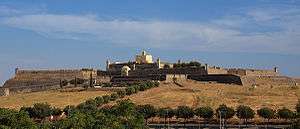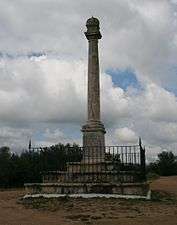Battle of the Lines of Elvas
| Battle of the Lines of Elvas | |||||||
|---|---|---|---|---|---|---|---|
| Part of Portuguese Restoration War | |||||||
 Fort of Santa Luzia in Elvas | |||||||
| |||||||
| Belligerents | |||||||
|
|
| ||||||
| Commanders and leaders | |||||||
|
António Luís de Meneses Sancho Manoel de Vilhena | Luis de Haro | ||||||
| Strength | |||||||
|
10,500:[2]
|
17,500: | ||||||
| Casualties and losses | |||||||
|
201 killed[5] 697 wounded[6] |
11,200 men killed or captured[7] All the artillery captured[8] | ||||||
The Battle of the Lines of Elvas (Portuguese pronunciation: [ˈɛɫvɐʃ]), was fought on 14 January 1659, in Elvas, between Portugal and Spain during the Portuguese Restoration War. It ended in a decisive Portuguese victory.
History
By 1659, the Portuguese Restoration War had been raging for 18 years, and had degenerated into a stalemate. Other than minor cavalry raids, neither the Spanish Hapsburg Army nor the Portuguese had managed to claim a decisive battlefield victory. King Philip IV of Spain sought to end the conflict by laying siege to and capturing a major Portuguese position, and by luring out and destroying any Portuguese army that tried to aid the embattled garrison. Elvas was chosen as a target due to the threat it posed to the Spanish city of Badajoz, as seen during the Battle of Montijo in 1644 when a Portuguese army based at Elvas had crossed the border, raided Spanish towns, and attacked a Spanish army. The capture of Elvas and Fort Santa Luzia would also allow the Spanish Army to proceed down the Estremoz road to the Portuguese capital of Lisbon if they so chose. The Portuguese court was aware of the Spanish threat to the city and had greatly reinforced the strength of the city's defensive fortifications during the course of the war. However, years of only minor military action in the area had degraded the readiness of the garrison, and the city was unprepared for a siege. In addition, though the Spanish preparation for the offensive was detected, the vast majority the Portuguese Army was deployed in the north of the country in preparation for a suspected Spanish attack.[9]
In December 1658 a Spanish army commanded by D. Grandee Luis de Haro camped in the frontier of the Caia River with 14,000 infantry, 3,500 cavalry, and several pieces of artillery. The Spanish preparation for the siege of Elvas took several days, time which the Portuguese used to further prepare the city defenses and call for aid. De Haro distributed his troops in trenches, giving orders to kill everyone that approached the city, and prepared his army to confront the relief force the Portuguese would inevitably send. The Spanish bombarded the city, causing panic and casualties among the civil population, while disease claimed 300 lives a day inside the walls. The only way the situation could turn in favor of the Portuguese was with the help of a relief army. Queen-Mother Luisa de Guzman decided to call for António Luís de Meneses, Count of Cantanhede, and gave him the command of all Portuguese troops in Alentejo. She also transferred to the same theatre of operations to Sancho Manoel de Vilhena, who assumed the post of field marshal.[10]
Meneses, although facing extremely poor logistical conditions, managed to gather an army in Estremoz. He organized recruitment efforts in Viseu and in the Madeira islands and united the garrisons of Borba, Juromenha, Campo Maior, Vila Viçosa, Monforte, and Arronches into a single army. The gathered army had 8,000 infantry, 2,500 cavalry, and seven cannons. The Portuguese left Estremoz and occupied the hill of Assomada, from where they could see the city of Elvas and the enemy lines.
On 17 January, around 8 o'clock in the morning, the Portuguese attacked near the village of Murtais, where the Portuguese infantry fought with such ferocity that the Spanish were driven from that segment of their trenches. When the Spanish cavalry moved to intervene, the limited Portuguese cannon fired into them. Using his infantry in conjunction his artillery, Meneses was able to stall several Spanish cavalry charges. The Portuguese cavalry was then ordered to counter-charge the retreating Spanish cavalry, and, despite the superior Spanish numbers, routed them. With this early action won, Meneses divided his army, drawing up one part to attack the Spanish trenches, while sending the other around the Spanish flank. Having lost most of his cavalry, De Haro was unaware of this movement. From his position on Assomada hill, Meneses then signaled the Elvas garrison to sally forth from their defenses and join the attack. Meanwhile, De Haro continued to conduct a pitched defensive battle centered on his static trench line, and failed to deal with the encircling Portuguese forces. By mid afternoon the Spanish were valiantly defending their lines, but after some time Meneses's dual flanking maneuver began to wear down the defenders, who were now under attack from multiple directions. De Haro abandoned his strategy too late in the day, and the Spanish eventually lines broke, with thousands of soldiers fleeing in panic.[11][9] Cantanhede wasted no time in the pursuit of the Spanish, and harried them for the next three days as they retreated to Badajoz. Many Spaniards became trapped against the Caia river and were forced to surrender. The rout was so total that the Spanish artillerymen were unable to spike (disable) their cannons before the Portuguese captured them, and Cantanhede came into possession of 22 assorted artillery pieces among other loot.
Spanish casualties were heavy; Of the 17,500 men commanded by De Haro, only 5,000 infantry and 1,300 cavalry managed to reach Badajoz.[12] The Portuguese suffered some 200 killed and 700 wounded.
After his success in the battle, Meneses, Count of Cantanhede, received among several honours the title of Marquis of Marialva on 11 June 1661. Six years later at the Battle of Montes Claros, Meneses used a strategy similar to the one he used at the Battle of the Lines to repulse a similar Spanish cavalry charge.
A commemorative monument stands on the site of the battlefield. The Garrison Border Town of Elvas and its Fortifications were declared a World Heritage Site in 2012.
Pictures
Notes
- ↑ Stearns, Langer, p.331
- ↑ Ribeiro, p.84
- ↑ Ericeira, p.213
- ↑ Ericeira, p.213
- ↑ Ericeira, p.229
- ↑ Ericeira, p.229
- ↑ Ericeira, p.229
- ↑ Ribeiro, p.85
- 1 2 Marcus, Tuell (1952). History of War in the Iberian Peninsula. Baltimore: William & Wilkins Publishing House. pp. 235–237.
- ↑ Ericeira, p.217
- ↑ Jaques, "At Elvas, 20 miles west of Badajoz, De Haro was routed by Castello-Melhor and Sancho de Villa Flor and fled in panic" p.333
- ↑ Ericeira, p.227
References
- Peter N. Stearns, William Leonard Langer, The Encyclopedia of world history: ancient, medieval, and modern, chronologically arranged (2001)
- Marcus Tuell, History of War in the Iberian Peninsula, (1952)
- Ângelo Ribeiro, História de Portugal: A Restauração da Independência-O Início da Dinastia de Bragança (2004) ISBN 989-554-110-4
- Tony Jaques, Dictionary of Battles and Sieges: A-E (2007) ISBN 978-0-313-33537-2
- Luis de Menezes, Conde da Ericeira, Historia de Portugal Restaurado. 1657-1662 (1751)




